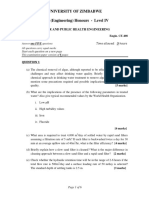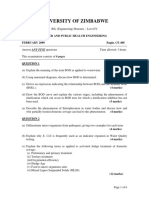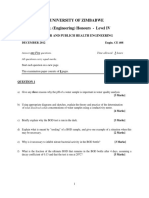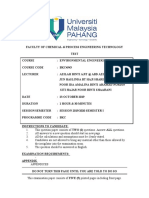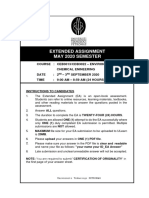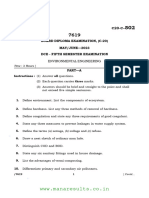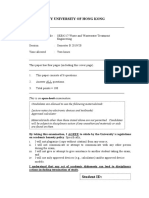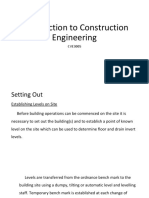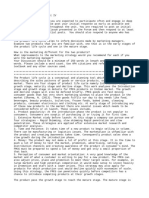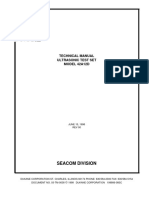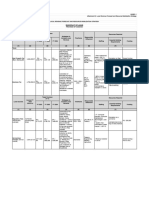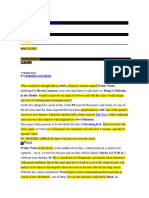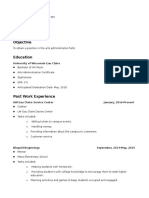COLLEGE/ FACULTY: Faculty of Engineering and Computing
SCHOOL/ DEPARTMENT: SOE/ Civil Engineering
UNIVERSITY OF TECHNOLOGY,
Final Examination, Semester 2 JAMAICA
Module Name: Environmental Engineering
Module Code: CVE 3007 and ENG 4023
Date: April 2022
Theory/ Practical: Theory
Groups: B.Eng. – Civil / B.Sc. Applied Science
Duration: Take Home (48 hrs)
Instructions:
1.
ANSWER ALL QUESTIONS.
2.
EACH QUESTION MUST BEGIN ON A NEW PAGE.
3.
LEAVE TWO LINES BETWEEN PARTS OF A QUESTION.
4.
SHOW CLEARLY ALL EQUATIONS USED FOR CALCULATIONS.
5.
ANSWERS MUST BE NUMBERED IDENTICAL TO THE QUESTION BEING ANSWERED.
6.
THE INTENDED MARK IS INDICATED AT THE BEGINNING OF EACH QUESTION.
7.
A FORMULA SHEET IS ATTACHED.
Page 1 of 8
�Question 1 (25 Marks)
(a) A city water department has decided that two alternatives are available to meet the need for an additional 40 MGD. One is to build a dam/reservoir (D&R
Plan) and the other is to engage in a strong program of water conservation and education (C&E Plan). The D&R plan is expected to require an initial capital investment
of US$35,000,000 with operation and maintenance costs thereafter averaging at US$500,000 per year. The C&E Plan will require a capital investment of
US$12,000,000 and thereafter US$2,000,000 will be required per year to subsidize water conservation equipment for the city.
The planning horizon for both alternatives is 20 years. If an interest rate of 8% is used, identify the best alternative based on a present worth analysis.
(10 marks)
(b) Bullstord, Westmoreland a remote rural community within Jamaica has been experiencing severe water shortages for the past four (4) months. The area
was normally served by three standpipes. They would receive water, once per week on a Sunday, albeit at extremely low pressures. There is a river some 2 km away, so
they routinely collect water there for both potable and non-potable uses. The citizens typically treat water for drinking by adding two drops of bleach to every five
gallons. Suffice it to say the collected water, despite their interventions, does not consistently meet National Primary Drinking Water Standards and many often do not
have the funds to purchase bottled water.
A need, therefore, exists for a Point of Use Water Treatment Method (POU) to provide safe drinking water for every member of each household. The method designed
must be user-friendly, inexpensive, practical, and effective.
(i) Identify a POU Treatment method appropriate for the scenario described? Briefly describe how it works in terms of the physical, chemical, and/or
biochemical processes involved in the removal of clearly identified pollutants. Include chemical equations where appropriate.
(15 marks)
Question 2 (25 Marks)
A reservoir stores water to be treated by a nearby water treatment plant. The main source of water is a river. On its way from the mountains, the river travels through
sections of limestone and picks up an “off” odour and colour.
(a) Draw a process flow diagram of a water treatment plant that would bring the raw water up to potable water standards. All relevant unit operations must be
clearly identified on your diagram. (8 marks)
(b) Would the process flow diagram in Question 2a differ if the raw water coming into the water treatment plant came solely from two nearby artesian wells?
Give a reason for your answer. (5 marks)
(c) Describe how the unit operations on the plant defined in Question 2b would remove suspended particles and organic compounds from the raw water.
(6 marks)
(d) A chemical analysis of a sample of river water yielded the data shown in Table 1.
Table 1 Chemical Analysis of River Water
Page 2 of 8
� Ion/Parameter Concentration (mg/L)
2+
Ca 40
2+
Mg 30
3+
Fe 25
2+
Mn 6
-
Cl 120
2-
SO4 225
-
HCO3 165
pH 7.5
Determine the hardness as CaCO3. Evaluate your result. (6 marks)
Question 3 (25 Marks)
The 1970 Clean Air Act precipitated the development of the National Ambient Air Quality Standards, NAAQS. These standards apply to the ambient (outdoor) air.
Associated with these standards are the terms criteria pollutants, primary standards, and secondary standards.
(a) List these criteria pollutants (3 marks)
(b) Distinguish between primary and secondary standards (4 marks)
(c) Given the atmospheric altitude versus temperature profile in Table 2, evaluate the atmospheric stability? Show all working. The dry adiabatic lapse rate is
0
- 1.0 C/100 m.
Table 2 Temperature Profiles Ambient Air
0
Altitude Z, m T ( C)
0 23
100 24
200 25
400 25
500 24
700 23
(12 marks)
(d) 0
A factory releases a plume into the atmosphere from a 100 m stack. The temperature of the plume is 21 C assuming that it rises at the dry adiabatic lapse
rate, draw a clearly labeled diagram to illustrate the shape the plume would form. (3 marks)
(e) How would your answer to part (d) change if the stack height were 500m? Use a diagram to complete your answer.
(3 marks)
Page 3 of 8
�Question 4 (25 Marks)
Consider Figure 1 given.
Figure 1 A conventional activated sludge wastewater treatment plant
(a) What is your understanding of the term biosolids? (4 marks)
(b) According to the NRCA Regulations of 2013, at what unit operations would biosolids be generated? Identify these unit operations by listing them.
(4 marks)
(c) Describe how these biosolids could be recycled or their quantities reduced to lessen the current burden on Jamaica’s landfills.
(8 marks)
(d) Consider Table 3 as given,
Table 3 Characterization of Solid Waste Worldwide (% wet weight) (UNEP, 2016)
Page 4 of 8
�In what ways are the wastes from developed countries different from those of developing countries?
(4 marks)
(e) Compost is biologically stabilized organic material used primarily as soil fertilizer or conditioner on growing plants. For the biological process to be
effective however certain conditions must be met. Briefly describe these conditions. (5 marks)
TOTAL MARKS = 100
END OF EXAM
Page 5 of 8
� FORMULA SHEET
Table 1 Equivalent Weights
Page 6 of 8
�NB. Equivalent weight of calcium carbonate, CaCO3 = 50 mg/meq
Page 7 of 8
�Page 8 of 8

